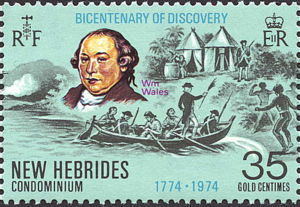English mathematician, astronomer, and author
Biography
William, son of John Wales, was baptised on 1 March 1734/5 in Warmfield, Yorkshire, England.[1] His parents were John Wales and Sarah (Cay) Wales. John, from Wakefield in Yorkshire, England, was described as a 'banksman'; since the River Aire and the River Calder were nearby, he probably worked near them, following in the footsteps of previous members of the Wales family, who had lived there since the 17th century.
William Wales worked as assistant to the plumber to King George III, but by the 1760s he was writing for The Ladies' Diary, a publication of calendars, sunset and sunrise times, and phases of the moon. In 1762 he published his first poem: Ode to William Pitt, price one shilling.
In 1765 Wales married Mary Green, sister of the astronomer Charles Green. The parish register states: "William Wales, Gent. of the parish of Greenwich in Kent and Mary Green, Spinster of the same Parish, were married by Licence in this Church this Fifth day of September 1765 by me John Green AB (her brother). This marriage was solemnized between us. [signed] Wm Wales. Mary Green. In the presence of John Naylor. Jos. Stack." [2]
Also in 1765, Wales began his career in astronomy, working for the Astronomer Royal Nevil Maskelyne, who was compiling his Maskelyne's Nautical Almanac. During his voyage with Captain Cook, he wrote:
"I have ventured to call the Maskelyne Islands by the name of a person to whom I owe very much indeed; one who took me by the hand when I was friendless, and never forsook me when I had occasion for his help."
The Almanac was published in 1766 (and every year since then). Wales was paid £70, rising to £75 the following year.
In 1768, Wales and his assistant Joseph Dymond set sail for the Prince of Wales Fort on Hudson Bay, Canada. They intended to observe the transit of Venus, when Venus seems to travel across the sun, but of course does not eclipse it, being relatively small. The expedition, ready for the 1769 event, was arranged by the Royal Society of London for Improving Natural Knowledge (now known as the 'Royal Society'). Wales presented his report in March 1770, and the detail it contained impressed James Cook so much that he invited Wales to join his expedition to circumnavigate the globe aboard the Resolution.

|
| 1777 portable observatory by Wales and Bayly |
When Wales accompanied Cook on his next voyage, he was joined by William Bayly, who worked as an assistant at the Royal Observatory. Wales and Bayly's prime objective was to test Larcum Kendall's K1 chronometer, which exceeded expectations. The voyage lasted from 1772 to 1775.
Upon his return, Wales was appointed Master of the Royal Mathematical School at Christ's Hospital and was elected a Fellow of the Royal Society in 1776. The writer Leigh Hunt, one of Wales' pupils, remembered him as "a good man, of plain simple manners, with a heavy large person and a benign countenance."
In 1795, Wales was nominated for the position of Secretary of the Board of Longitude by the First Lord of the Admiralty, Earl Spencer. His nomination was confirmed on 5 December 1795.
Wales died on 29 December 1798.[3] For a transcript of his Will, please click through to freespace page[4]
Bibliography
- Astronomical observations, made by order of the Royal Society, at Prince of Wales's Fort[5]
- "Journal of a voyage, made by order of the Royal Society, to Churchill River, on the North-west Coast of Hudson's Bay". Philosophical Transactions of the Royal Society of London. 60: 109–136. 1771.
- The Method of Finding the Longitude by timekeepers London: 1794.
Sources
- ↑
Baptism:
"England Births & Baptisms 1538-1975"
FindMyPast Transcription (accessed 3 October 2023)
William Wales baptism on 1 Mar 1734, son of John Wales, in Warmfield, Yorkshire, England. - ↑
Marriage:
"Kent Marriages And Banns"
FindMyPast Transcription (accessed 5 October 2023)
William Wales marriage to My Green on 5 Sep 1765 in Greenwich, St Alfege, Kent, England. - ↑ Wikisource contributors, "Dictionary of National Biography, 1885-1900/Wales, William," Wikisource , https://en.wikisource.org/w/index.php?title=Dictionary_of_National_Biography,_1885-1900/Wales,_William&oldid=10753478 (accessed October 6, 2023).
- ↑ PROB 11/1318/91 Description: Will of William Wales, Master of the Mathematical School in Christ's Hospital of Christchurch , City of London Date: 11 January 1799 Held by: The National Archives, Kew
- ↑ https://archive.org/details/astronomicalobse00wale/page/2/mode/2up?q=%22William+Wales%22 Astronomical observations, made by order of the Royal Society, at Prince of Wales's Fort, on the north-west coast of Hudson's Bay. by Wales, William, 1734?-1798 Publication date 1770 Publisher London, : Printed by W. Bowyer and J. Nichols.
See Also:
- William Wales on Wikipedia
- Wales, Wendy (2015). Captain Cook’s Computer: the life of William Wales, F.R.S. (1734-1798). Hame House. ISBN 978-09933758-0-4.
- Captain Cook's first voyage
It may be possible to confirm family relationships. It is likely that these autosomal DNA test-takers will share some percentage of DNA with William:
-
~0.78%
Dennis Wales
 :
MyHeritage DNA, GEDmatch H819887 [compare]
:
MyHeritage DNA, GEDmatch H819887 [compare]
 Sheri Havens
Sheri Havens
Featured Eurovision connections: William is 34 degrees from Agnetha Fältskog, 24 degrees from Anni-Frid Synni Reuß, 31 degrees from Corry Brokken, 24 degrees from Céline Dion, 26 degrees from Françoise Dorin, 26 degrees from France Gall, 27 degrees from Lulu Kennedy-Cairns, 30 degrees from Lill-Babs Svensson, 23 degrees from Olivia Newton-John, 31 degrees from Henriette Nanette Paërl, 37 degrees from Annie Schmidt and 16 degrees from Moira Kennedy on our single family tree. Login to see how you relate to 33 million family members.


